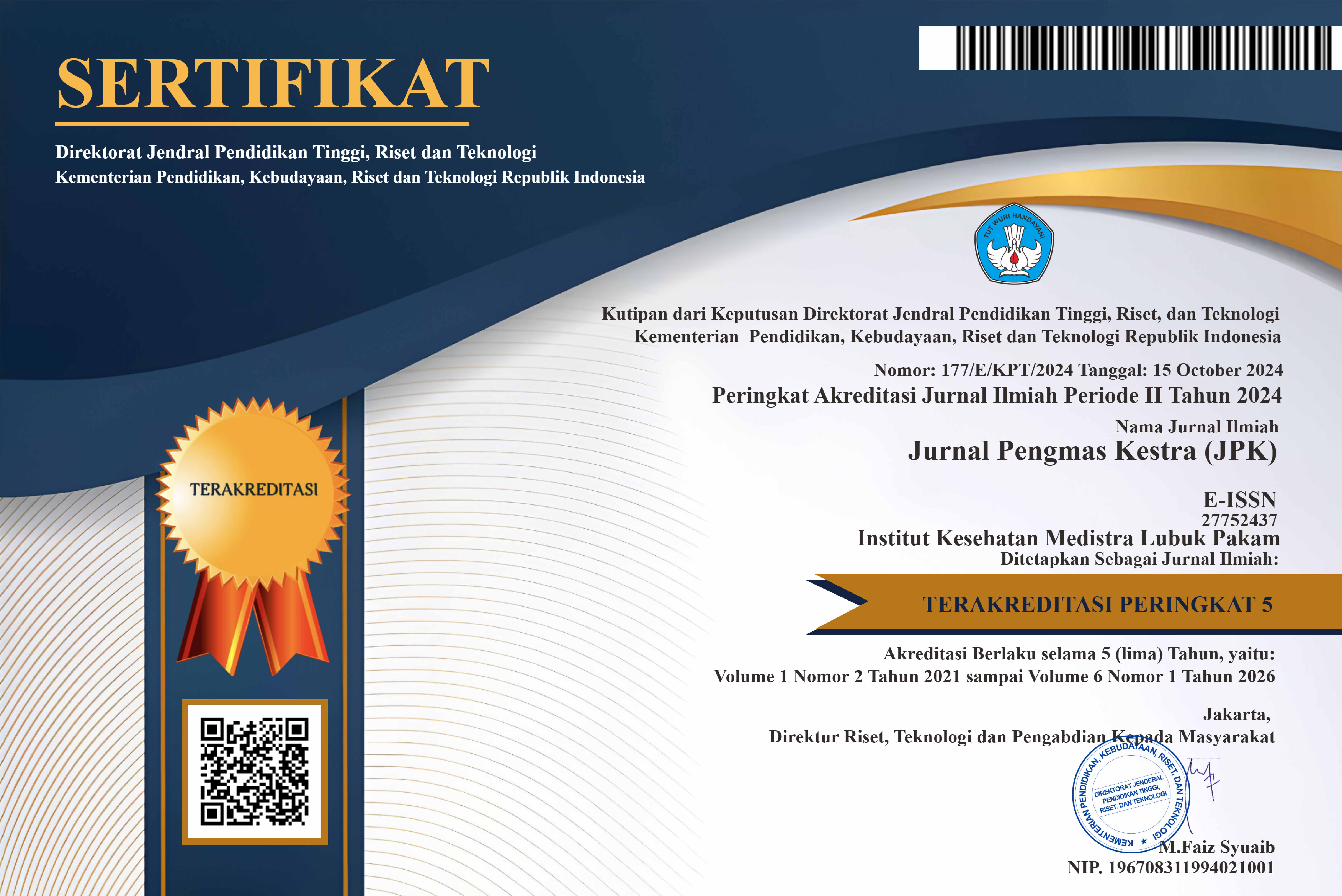Training on The Application of Nebulisation with The Semi Fowler Position in Controlling The Breath Frequency of Bronchial Asthma Patients At The GM Hospital
DOI:
https://doi.org/10.35451/jpk.v4i1.2194Keywords:
Bronchial Asthma, Respiratory Frequency, Nebulization, Training, Semi FowlerAbstract
Respiratory disorders can attack anyone indiscriminately. It is often found that types of respiratory diseases such as asthma and ARI. The causes are varied, such as dirty air, bacteria, and viruses. The world death rate of 20% is caused by asthma which is estimated for the next 10 years if it is not treated properly. Bronchial asthma is a type of non-communicable but chronic disease of varying severity in the respiratory tract. Pharmacological therapy such as nebulization and non-pharmacological therapy such as the semi-Fowler position are appropriate treatments to be given to patients with bronchial asthma so that they can regulate the patient's respiratory frequency. Giving a nebulizer can overcome shortness of breath, relax bronchial spasms, liquefy phlegm, and clear the airways. Meanwhile, the semi-Fowler position can provide comfort in breathing so that the lungs become wider. This training activity was attended by PkM participants, namely 20 nursing staff. The series of PkM activities include the delivery of material, discussions, therapy demonstrations, and simulations of treating bronchial asthma patients using nebulization and the semi-Fowler position. The media used are a nebulizer, teaching aids, and SOP. The results of the PkM implementation show that the PkM participants have understood the benefits of nebulization in the semi-Fowler's position. Apart from that, PkM participants were also able to carry out the two treatments by the SOP which was implemented through simulation.
References
Agina P, Suwaryo W, Amalia WR, dan Waladani B. (2021). Efektifitas Pemberian Semi Fowler dan Fowler terhadap Perubahan Status Pernapasan pada Pasien Asma, 1–8.
Arifian L dan Kismanto J. (2018). Pengaruh Pemberian Posisi Semi Fowler Terhadap Respiration Rate Pada Pasien Asma Bronkial Di Puskesmas Air Upas Ketapang. Jurnal Kesehatan Kusuma Husada - Juli 2018. Vol. 9 No. 2.
Astuti WT, Marhamah E, Diniyah N. (2019). Penerapan Terapi Inhalasi Nebulizer Untuk Mengatasi Bersihan Jalan Napas Pada Pasien Broko pneumonia. Jurnal Keperawatan Karya Bhakti, Vol 5 No. 2 Juli 2019, p-ISSN : 2477 – 1414, Hal 8 – 13.
Chanif, C., & Prastika, D. (2019). Position of Fowler and Semi-fowler to Reduce of Shortness of Breath (Dyspnea) Level While Undergoing Nebulizer Therapy. South East Asia Nursing Research, 1(1), 14-19.
Erlien. (2018). Penyakit Saluran Pernafasan. Jakarta Selatan: PT Sunda Kelapa Pustaka.
Sondakh SA, Onibala F, Nurmansyah M. (2020). Pengaruh Pemberian Nebulasi Terhadap Frekuensi Pernafasan Pada Pasien Gangguan Saluran Pernafasaan. Jurnal Keperawatan (JKp), Vol 8, No 1 Februari 2020, ISSN 2302-1152, Hal 75 – 82.
Surastini RK. (2019). Gambaran Asuhan Keperawatan Pemberian Prosedur Nebulizer Untuk Mengatasi Bersihan Jalan Nafas Tidak Efektif Pada Anak Bronkopneumonia. Jurnal Keperawatan,Politeknik Kesehatan Denpasar. Hal 7 – 19.
Tafdhila, & Kurniawati, A. (2019). Pengaruh Latihan Batuk Efektif Pada Intervensi Nebulizer Terhadap Penurunan Frekuensi Pernafasan Pada Asma Di Instalasi Gawat Darurat. Babul Ilmi_Jurnal Ilmiah Multi Science Kesehatan, 11, 117–127.
World Health Organization (WHO). Chronic Respiratory Disease. (2017).http://www.who.int/respiratory/asthma/en/. World Health Organization (WHO). WHOQOL-Bref: Introduction, Administration, Scoring And Generic Version Of The Assesment (Field Trial Version). Ganeva: World Health Organization.
Downloads
Published
Issue
Section
License
Copyright (c) 2024 Anita Gandaria Purba, Elfrida Simanjuntak, Samuel Ginting, Freddy Kalvin

This work is licensed under a Creative Commons Attribution 4.0 International License.
Copyright in each article is the property of the Author.




















